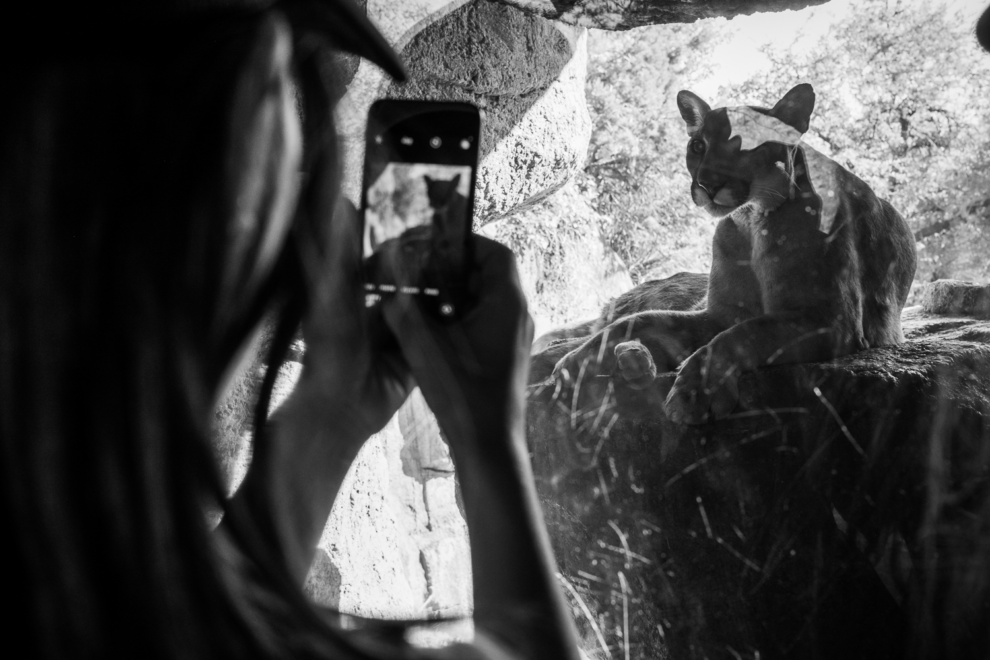Like many others, I typically listen to my local public radio station while I’m driving, my attention drifting in and out as I gaze out of the windshield. But my ears pricked up on a recent morning once I realized the entire newscast was dedicated to local wildlife.
There was something about the pack of some 30 to 50 javelinas that ripped up a golf course near Sedona, Arizona, about 200 miles from where I live, followed by talk of the recent sighting of a jaguar, a species that ranged across Arizona and Sonora, Mexico, until construction of the border wall blocked the way last year. Finally, there was an update on Mexican wolf reintroduction efforts in New Mexico and Arizona. The results were mixed: Nine of the wolves had died or been killed recently.
Whether it’s through invasive species, habitat loss, resource extraction, grazing, pollution or climate change, our own lives are constantly intersecting with those of wild animals. Of course they are: Despite our arrogant sense of superiority over nature, we are all absolutely dependent on each other and on our habitats; biodiversity and a healthy, functioning environment are essential to sustaining life. Entire ecosystems have long been altered and degraded by humans to the point that they’re nearing collapse more rapidly than we had ever imagined. Human impact defines the current era — the Anthropocene, or as some pointedly call it, the Capitalocene.
As I sat in my car, listening to the news, I felt helpless, even mournful. What would it take for most of us to understand that the javelinas’ raid on that heavily irrigated golf course in the desert was a sign that maybe irrigated golf courses shouldn’t be in the desert to begin with? The way I saw it, the javelinas weren’t invading the site; they were reclaiming it. After all, the javelinas’ needs — for food, for space — are more basic than a few privileged humans’ desire to play golf. When, later, I told our daughter about this story, her response was more reasonable than mine was.
Why, she asked, couldn’t golf courses just be smaller and made of dirt? There could be compromise; Sedona could follow the lead of Las Vegas and ban “nonfunctional” grass. In any case, she said, the javelinas were just speaking up and demanding what they felt was theirs, too. Now it was our turn to respond.
I wish I still carried some of her innocence. Some days, I do, and compromise between species, more tolerance and humility, feels possible. The last time we visited our local zoo, my daughter pointed out the animals’ faces— look how cute! — and delighted in their calls. But whenever I heard the squirrel monkeys’ high-pitched cries, my mind immediately went to a dark place: All I could think about was how captivity might impact the animals’ emotions and how those emotions may be undermined or misunderstood by us.
For years now, researchers like Marc Bekoff, professor emeritus of ecology and evolutionary biology at the University of Colorado Boulder, have acknowledged that animals are conscious beings, capable of complex feelings like empathy and emotion. Yet that awareness hasn’t been enough to change our behavior toward them. Then again, it sadly — and obviously —hasn’t kept us from hurting our fellow human beings, either. We haven’t changed, even though we now know that our impact — not just on wild animals but on the ecosystems that they, and we, depend on — won’t be easily reversed.
Let’s take the Arizona Mexican wolf pup reintroduction effort that I heard about in the news: Back in the 1970s, the species was on the edge of extinction — the last sighting of a Mexican wolf in the wild happened in 1970. Then, 25 years ago, a federal reintroduction program was launched in New Mexico and Arizona; today, almost 250 Mexican wolves are believed to be in the wild, although every year, humans illegally kill one out of 10. Think about it: For the past 25 years, scientists have been working diligently to restore the native wolf population, and yet are unable to neutralize its greatest threat. The wolf recovery effort is necessary, but it’s extremely difficult because we humans keep getting in the way. We hold the key to the animals’ future: Whether they survive or go extinct largely depends on us.
I know I have a romantic notion of nature; many people, particularly scientists, have told me. Recently, I felt that naiveté creeping in as I spoke with Jeff Crooks, an ecologist in San Diego, California, who focuses on coastal wetlands.
He told me it’s understandable that we should be concerned about the collapse of species but added that “context is everything.” Not all human impacts on the environment will lead to destruction, just as not all invasive species are bad for ecosystems. Take, for example, the eucalyptus tree, which is native to Australia and was introduced to California about 150 years ago. Today, it is a favorite winter home for an imperiled native species: the monarch butterfly.
The honeybees we so love were brought to North America from Europe in the 17th century. Also, consider us: Could we be the most invasive species of all? We spread across the planet around 15,000 years ago and have been moving ever since. Historically, though, we have been a part of our ecosystem instead of separate from it. We might behave like a noxious invasive species, but we don’t have to.
We should be having candidconversations about all of this, Crooks said, especially in the age of climate change. And those conversations need to be informed by science and data, because those are the only tools that will help us make increasingly harder decisions about how to adapt or preserve life on earth.
“What we want is for people to guard it,” he told me, “to restore that sort of cultural landscape.”
I fight the worst-case scenarios that can keep me up at night. I don’t do well with helplessness, because helplessness leads to paralysis, to disassociation, to no longer wanting to take care of what matters to us most. Instead, I think about how it must be a hopeful sign that my local news now regularly covers the challenges of coexistence and possible solutions to our problems, and that our daughter, in her view of both humans and nature, is much more empathetic and wise than I could ever be. That’s progress.
Source: High Country News










